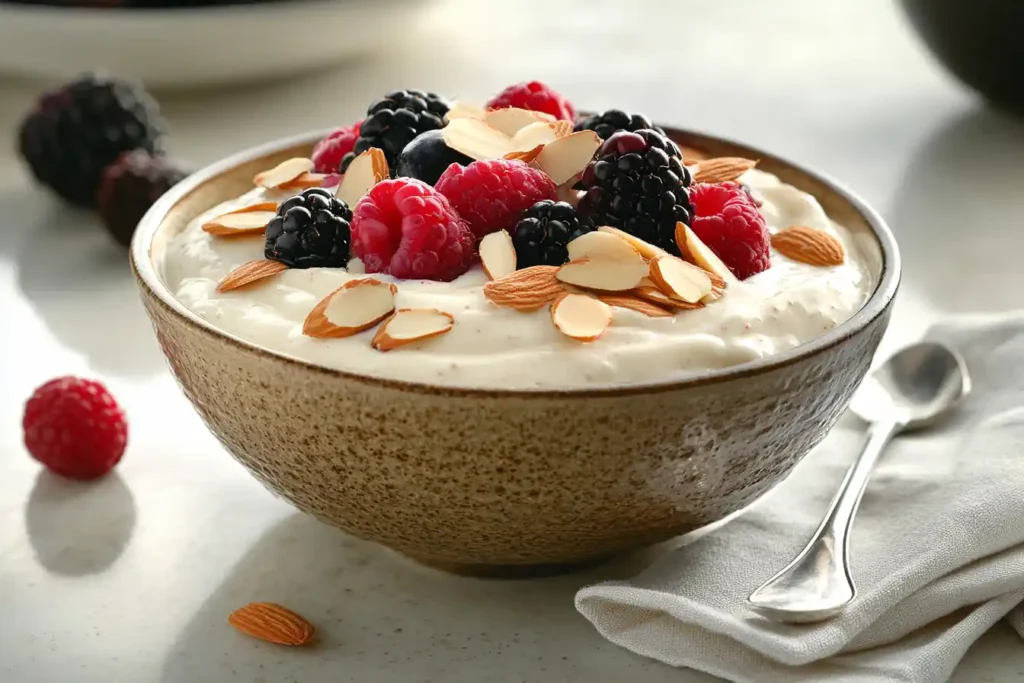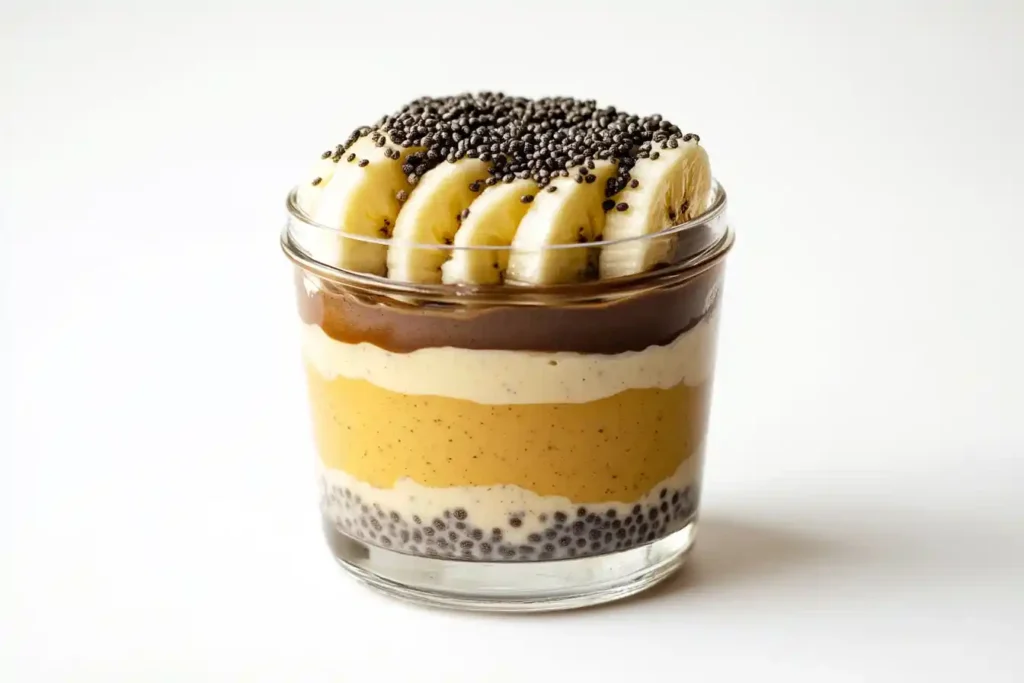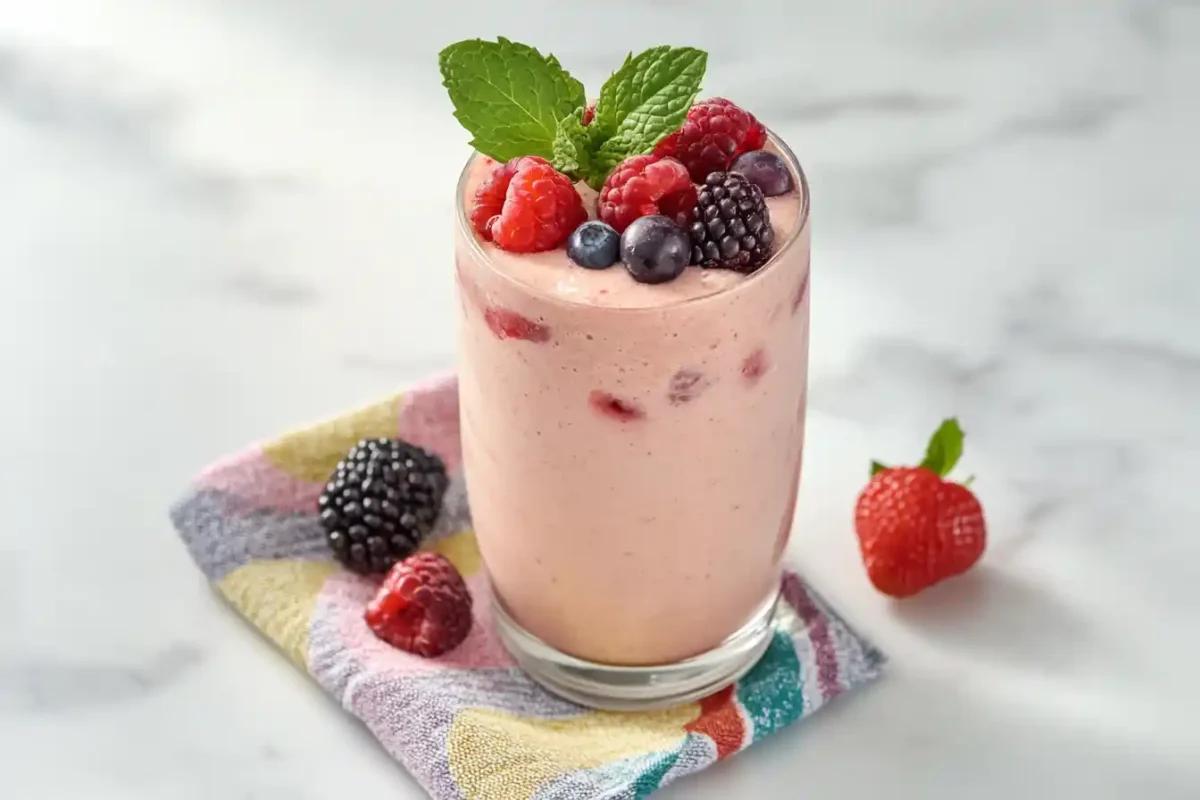Introduction
What Are Protein Puddings?
Protein puddings are creamy desserts fortified with a high protein content. They’re designed to provide a healthier alternative to traditional puddings, which are often packed with sugar and empty calories. But these modern treats are more than just a sweet indulgence—they’re frequently marketed as functional foods that can support your fitness goals, weight management, and overall health.
Available in both homemade recipes and commercial varieties, protein puddings often contain ingredients like whey or plant-based protein, milk or milk alternatives, and natural or artificial sweeteners. These puddings have become a staple in the fitness world due to their ability to deliver high-quality protein in a delicious format.
Nutritional Profile of Protein Puddings
Before jumping to conclusions about whether protein puddings are healthy, it’s essential to understand their nutritional composition. Typically, these treats are low in carbohydrates and fats but rich in protein. They may also include additional nutrients like calcium and iron, depending on the ingredients. That said, not all protein puddings are created equal. Some are laden with artificial sweeteners and additives, which can detract from their health value.
This article will explore the nitty-gritty of protein puddings, including their pros and cons, so you can make an informed choice. Whether you’re curious about their role in a balanced diet or how they stack up against other snacks, we’ve got you covered.
Understanding Protein Puddings
What Are Protein Puddings?
Protein puddings are a modern twist on the classic creamy dessert, designed to combine indulgence with nutritional benefits. At their core, these puddings are fortified with high-quality protein sources like whey, casein, or plant-based proteins. Ingredients often include milk or plant-based alternatives, sweeteners (natural or artificial), thickeners, and sometimes flavor-enhancing elements like cocoa, vanilla, or fruit purees.
Homemade protein puddings are celebrated for their versatility and ingredient transparency, as seen in this protein pudding recipe. With simple recipes, you can create a pudding tailored to your dietary preferences using whole ingredients. On the other hand, commercially available protein puddings provide convenience, offering pre-packaged options that are easy to grab on the go. However, they may include preservatives, artificial flavors, and added sugars. Choosing between the two often boils down to individual needs and priorities.
Nutritional Profile of Protein Puddings
Protein Content
Protein puddings shine in their protein content, often delivering 10 to 20 grams per serving. This makes them an excellent choice for those looking to meet their daily protein intake, especially compared to traditional snacks like cookies or chips, which are low in protein.
These puddings often rely on high-quality protein sources such as whey (for muscle recovery), casein (slow-digesting for sustained energy), or plant-based proteins like pea or soy (for vegan options). Their protein content is a major reason they’re favored by athletes and fitness enthusiasts.
Carbohydrates and Sugars
The carbohydrate content in protein puddings can vary significantly depending on the brand and ingredients. Many low-carb options cater to individuals watching their sugar intake, utilizing sugar substitutes like stevia or erythritol. However, some commercial products sneak in added sugars to enhance flavor, which can lead to higher calorie counts.
When comparing products, look for options with minimal added sugars or opt for homemade recipes to better control carb levels.
Fats and Calorie Count
Most protein puddings are relatively low in fats, with the calorie count ranging from 100 to 200 per serving. This makes them a moderate-calorie snack, suitable for maintaining a balanced diet.
However, it’s important to assess the type of fat used. Healthy fats from sources like coconut milk or nuts can provide additional nutritional benefits, whereas hydrogenated oils or artificial fats can detract from the overall healthfulness of the product.
Vitamins and Minerals
While protein puddings are primarily celebrated for their protein content, they can also offer a dose of essential nutrients. Calcium is commonly found in dairy-based puddings, supporting strong bones and teeth, while iron from plant-based proteins aids in oxygen transport. Some products even fortify their puddings with added vitamins and minerals to appeal to health-conscious consumers.
Nutritional Breakdown of Protein Puddings (Per 100g Serving)
| Nutrient | Amount (Per 100g) |
|---|---|
| Calories | 120 kcal |
| Protein | 15g |
| Carbohydrates | 10g |
| Sugars | 3g |
| Fats | 3g |
| Saturated Fats | 1g |
| Fiber | 2g |
| Sodium | 150mg |
| Calcium | 100mg |
Health Benefits of Protein Puddings
High-Protein Content and Satiety
One of the standout benefits of protein puddings is their ability to curb hunger and promote satiety. The high protein content in these desserts slows down digestion, keeping you feeling fuller for longer. This not only helps prevent overeating but also supports better portion control throughout the day.
Studies back this up. Research published in the American Journal of Clinical Nutrition reveals that diets high in protein can significantly reduce hunger hormones, like ghrelin, while increasing the hormones that signal fullness. This makes protein puddings an excellent addition to diets geared toward weight management or healthy snacking.
The protein in these puddings, often derived from whey, casein, or plant-based sources, provides a slow-release energy boost, making it a satisfying option that fits perfectly between meals. Whether you’re managing a busy schedule or simply trying to resist a mid-afternoon sugar craving, protein puddings can be a delicious and practical solution.
Muscle Recovery and Growth
For those who lead active lifestyles, protein puddings can be a game-changer for post-exercise recovery. Protein plays a vital role in repairing and rebuilding muscle fibers after strenuous activities. Consuming protein shortly after a workout can enhance recovery and promote muscle growth.
Whey protein, commonly found in many protein puddings, is especially beneficial. It’s rapidly absorbed by the body, delivering essential amino acids to muscles quickly. For individuals who prefer plant-based diets, puddings with pea protein or soy protein offer comparable benefits.
Not only do these puddings help rebuild muscles, but they also reduce soreness and speed up recovery times. According to a study in the Journal of the International Society of Sports Nutrition, consuming high-quality protein immediately after exercise can lead to better strength gains and endurance over time.
Convenient Source of Nutrition

In today’s fast-paced world, convenience matters.Protein puddings tick all the boxes as a grab-and-go snack that’s both nutritious and satisfying, similar to this protein cookie recipe. Whether you’re rushing to work, heading to the gym, or in need of a late-night treat, these ready-to-eat options provide a healthy alternative to sugar-laden desserts or calorie-dense snacks.
Compared to other protein supplements like shakes or bars, protein puddings stand out for their texture and versatility. While shakes are great for hydration and bars for portability, puddings offer a creamy, indulgent experience that feels more like a treat than a supplement.
Moreover, they don’t require any preparation, making them ideal for anyone juggling multiple responsibilities. Homemade versions offer even more flexibility, allowing you to tweak the recipe to suit your dietary needs.
Potential Drawbacks of Protein Puddings
Added Sugars and Artificial Ingredients
Presence of Added Sugars
While protein puddings are marketed as healthier dessert options, some commercial varieties contain surprisingly high amounts of added sugars. These sugars are often used to enhance flavor, making the pudding more appealing to consumers. However, excessive sugar intake can lead to spikes in blood sugar levels, increased calorie consumption, and
weight gain over time.
For those trying to manage their health, reading the label is critical. Some puddings may advertise themselves as “low fat” but compensate with added sugars, which can negate their health benefits. Choosing options labeled “no added sugar” or making homemade versions allows you to control sugar levels effectively.
Artificial Sweeteners and Additives
To keep calories low, many protein puddings rely on artificial sweeteners like aspartame, sucralose, or acesulfame potassium. While these sweeteners reduce sugar content, they can have side effects for some individuals, such as bloating, digestive discomfort, or an altered gut microbiome.
Additionally, artificial additives like preservatives, thickeners, and artificial colors can be problematic. Although generally recognized as safe, long-term consumption of processed additives might not align with everyone’s dietary goals. For a cleaner option, focus on puddings with natural ingredients and minimal additives.
Calorie Density and Weight Management
Although protein puddings are often low in fat, their calorie content can still vary widely depending on the brand and serving size. Some include calorie-dense toppings or hidden sugars, which can inadvertently tip your daily caloric intake over the edge.
For those watching their weight, understanding portion sizes is crucial. A serving of protein pudding may provide essential nutrients, but consuming multiple servings in one sitting can lead to overconsumption. Balancing protein puddings within a structured diet plan ensures they support your goals rather than hinder them.
To integrate them smartly, consider pairing protein puddings with fresh fruit or vegetables to create a more satisfying and balanced snack. Moderation is the key to enjoying these desserts without compromising your dietary objectives.
Digestive Issues and Allergens
Lactose Intolerance and Dairy-Based Proteins
Many protein puddings use whey or casein, both derived from milk. For those with lactose intolerance, this can lead to bloating, diarrhea, or abdominal pain. Even though some puddings are labeled as “low lactose,” sensitive individuals may still experience discomfort.
Plant-based alternatives, made with soy, pea, or almond protein, offer a viable solution. These options cater to those avoiding dairy while still delivering high-quality protein content.
Allergens in Protein Puddings
Apart from dairy, other common allergens like soy, nuts, or gluten may be present in protein puddings. This makes label reading an essential practice for anyone with food allergies. Cross-contamination during manufacturing is another consideration, particularly for those with severe allergies.
To stay safe, opt for certified allergen-free products or prepare homemade protein puddings using carefully selected ingredients. This way, you’ll have full control over what goes into your treat.
Choosing a Healthy Protein Pudding
Evaluating Ingredient Lists
Prioritizing Whole Food Ingredients
When choosing a protein pudding, start by inspecting the ingredient list. The healthiest options often contain simple, whole food ingredients that are easy to recognize. For instance, a clean label might feature milk, protein isolate, cocoa, and a natural sweetener like stevia. These products avoid unnecessary fillers and focus on delivering quality nutrition.
By prioritizing puddings made with whole foods, you minimize exposure to potentially harmful chemicals while maximizing the health benefits. Additionally, fewer ingredients generally mean less processing, which is always a plus for maintaining a wholesome diet.
Avoiding Harmful Additives
Steer clear of products laden with artificial colors, flavors, and preservatives. These additives are often used to enhance taste and shelf life, but they can detract from the overall nutritional value of the pudding. For example, artificial sweeteners like sucralose or aspartame, while calorie-free, may cause digestive issues in some individuals.
Instead, opt for puddings that rely on natural flavorings, such as real vanilla extract or fruit purees. These choices not only taste better but also align more closely with clean eating principles.
Comparing Homemade vs. Store-Bought Options

Benefits of Homemade Protein Puddings
Making protein pudding at home offers unparalleled control over the ingredients. You can customize recipes to fit your dietary needs, whether that means using plant-based protein, low-carb sweeteners, or organic milk. Homemade puddings also let you avoid preservatives and artificial additives altogether.
Another advantage is flexibility. You can experiment with flavors, textures, and nutrient profiles by adding ingredients like chia seeds for fiber or fresh fruits for natural sweetness. This allows you to craft a dessert that is as nutritious as it is delicious.
Assessing Store-Bought Products
While homemade options are ideal, store-bought protein puddings provide unmatched convenience. To ensure you’re picking a healthy product, check the label for high-quality protein sources like whey isolate or pea protein. Avoid options with excessive added sugars, unhealthy fats, or long lists of unpronounceable ingredients.
Look for certifications such as “non-GMO,” “low sugar,” or “gluten-free” if those align with your health goals. Brands that disclose transparent sourcing and nutritional information tend to be more trustworthy.
Considering Dietary Needs and Preferences
Plant-Based and Vegan Options

For plant-based eaters, protein puddings made with alternative proteins like pea, soy, or almond protein are excellent choices, and you can find inspiration in these cottage cheese recipes.These options cater to vegans while still offering ample protein to support fitness and dietary goals. Plus, many plant-based puddings use almond or oat milk, which are naturally lower in calories and fat compared to dairy.
Vegan options also often skip common allergens like lactose, making them suitable for individuals with dairy sensitivities. Look for products labeled “vegan” to ensure there are no hidden animal-derived ingredients.
Gluten-Free and Allergen-Free Choices
For those with specific dietary restrictions, such as gluten intolerance or nut allergies, there are plenty of safe options on the market. Gluten-free puddings are often marked with certifications, and allergen-free varieties cater to sensitive individuals.
When selecting an allergen-free pudding, pay close attention to labels and opt for brands that emphasize cross-contamination prevention. Homemade puddings are an even safer bet, allowing you to avoid allergens entirely.
Part 6: Frequently Asked Questions
Protein puddings can act as a meal replacement in certain situations, but it depends on the product and your individual nutritional needs. Many puddings are high in protein but lack sufficient carbohydrates, fats, and fiber to qualify as a balanced meal. To make a protein pudding more meal-like, consider pairing it with fruits, nuts, or whole grains to provide a more comprehensive nutrient profile.
However, regularly replacing meals with puddings alone might lead to nutrient deficiencies over time. Use them as a convenient option occasionally, but not as a long-term meal replacement strategy.
Yes, protein puddings can be an excellent addition to a weight loss plan. Their high protein content promotes satiety, helping you feel full for longer and potentially reducing overall calorie intake. Moreover, they are often lower in sugar compared to traditional desserts, making them a healthier treat option.
For best results, choose puddings with minimal added sugars and moderate calorie counts. Incorporating them into a calorie-controlled diet can support weight management while still satisfying your sweet cravings.
The frequency of consuming protein puddings largely depends on your diet and fitness goals. For most people, enjoying a protein pudding once daily as a snack or post-workout treat is perfectly fine. If you have specific dietary needs, such as increased protein intake, you might consume them more often.
However, moderation is crucial. Over-relying on any single food, even one as nutritious as protein pudding, can lead to imbalances. Make sure to diversify your protein sources to ensure a well-rounded diet.
While protein puddings are generally safe, excessive consumption can lead to digestive issues like bloating, especially if they contain lactose or artificial sweeteners. Additionally, eating too many calorie-dense puddings might unintentionally hinder weight management goals.
Making Informed Choices About Protein Puddings
When considering whether protein puddings are healthy, the answer lies in making informed decisions based on your goals and needs. Protein puddings can be a nutritious, convenient option when chosen wisely. By understanding their nutritional content and potential drawbacks, you can incorporate them into your diet in a way that supports your health.
Whether you’re seeking a post-workout snack, a weight-loss-friendly dessert, or a convenient protein boost, moderation and ingredient quality are key. Opt for products with wholesome, minimally processed ingredients or make your own at home for maximum control.
Protein puddings are not a one-size-fits-all solution, but with the right choices, they can become a delicious and valuable part of a balanced diet.

